|
|
|
|
|
Synology DS715 |
|
Join the community - in the OCAU Forums!
|
Usage, Benchmarks and Conclusions
BENCHMARKING
Since I have two quad-core Synology NAS units here, it seems only fair that I benchmark them and compare.
Test System
Gigabyte Z97N-Wifi nano-ITX motherboard
Intel Pentium G3258 20th Anniversary Edition CPU @ 3.2ghz. (Yes, I know, itís running at stock, donít judge me too harshly)
8GB Gskill ďBlack DragonĒ RAM.
120GB Intel 330 SSD.
Running Windows 10 and Using LAN Speed Test
PC and both NAS units connected with 1gbit Ethernet via Netgear 1gbit switch.
Synology DS415+ NAS w/ four 2TB Western Digital ďRedĒ NAS drives in RAID6
Synology DS715 NAS w/ two 1TB Seagate Barracuda desktop drives in RAID1 (mirrored)
NB: While Iíd have prefered to have exactly the same drives in both NAS units, it couldn't be arranged. That said, given the different configurations between the two NASs in terms of number of drives and RAID setup, even identical drives would give us differing results.
Benchmarking was a little difficult as thereís no set CPU benchmark I could find for Synologyís DSM operating system, even though itís based on Linux, I wasnít game enough to roll benchmarking software from a random Linux distro. If anyone knows of suitable benchmarking software, let me know!
I decided I would use Totusoftís LAN Speed Test to run write and read tests of varying sizes, plus it operates in sequential - allowing me to specify a set number of packets to send in order - or simultaneous mode, where I could send two streams of the same sized patch.
The first three collection of readings to the left are fairly self-explanatory: the DS715 was able to read data almost twice as fast as it were able to write it in the first place, but the DS415+ was able to write 20% faster than allow it to be read, but the read speeds were at least 200-250MBit slower than the DS715. I suspect some of this disparity has something to do with the four drives in the DS415+, as opposed to the DS715ís two.
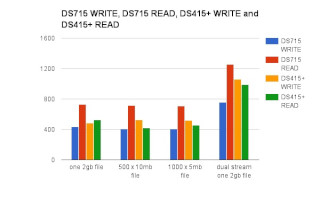 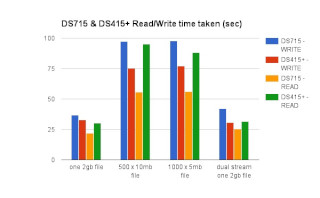
However, if you look at the CPU usage for both NASís, you can clearly see where the test switches from writing to reading from the DS715 - CPU utilization jumps from roughly 15% to almost 40%. Looking at the DS415+ logging, the usage is much more uniform and more importantly, rarely peaks above 20% - and bear in mind that itís doing RAID6 parity calculations as well.
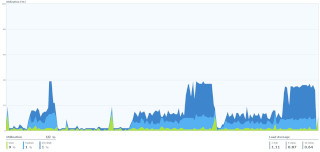 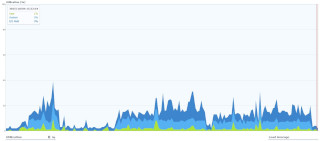
L: DS715 --- R: DS415+
Looking at the results for the right side, it requires a little bit of explanation because of the way the software works - the 10mb and 5mb packet results are small because it only sent two of them, simultaneously. I still ran those tests for the sake of completion, but because itís not directly comparable with the single stream results, I decided it would be only be fair to use the results of sending two 2gb packets simultaneously to compare to the single sequential stream results.
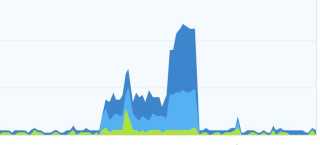 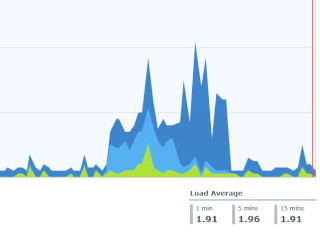
L: DS715 --- R: DS415+
As you can tell, the dual streams are very fast, but weíre more interested in CPU usage: for the DS715, the read operations almost hit 50%, but the DS415+ barely went above 30% on average, very briefly spiking just past 40%.
So what can we draw from this? Well, the DS715 has multiple cores, which is great for multiple operations but as I expected itís not a brute force beast with its mobile device CPU, even in our testing against a low-power Intel Atom processor doing more work. Compare that to a hand-rolled FreeNAS host using even a low cost desktop-class CPU and for pure grunt, itís hard to beat to the PC.
However, thatís not the point of buying a premade Synology NAS - youíre buying it for the complete package: the software, the flexibility of DSM, its range of tailored applications and the support. Plus the setup is much quicker and the power consumption presumably much lower.
AS PART OF A SMALL BUSINESS
The DS715 is squarely marked at the small/medium business section, although I would suggest itís only really meant for small office networks. With only two drives, the sensible configuration is RAID1 with one drive mirroring the contents of the other. Hard drives can fail and trusting your business data to a two drive system is asking for trouble, so youíd have to fit the DS715 into a broader solution.
With that in mind, Iíve been using it as a backup target it for the DS415+, backing up my photos folders - more on this below - but of course, thanks to Synologyís mature and expansive DSM operating system, itís capable of much more than just making copies of my travel snaps.
One thing that most people want from a Synology host is to run a copy of the Plex media server. Running Plex natively was one of the best elements of the original DS415+ and though it does take a little while for it to be recompiled and published for new models based on differing platforms, they're usually pretty quick with getting it out to the public. This is up to Plex however, not Synology, and Plex is running happily along with pretty much all the web hosting, VPNíing, printer queueing and mail hosting duties an office would need of it, amongst other services.
One service that Synology is promoting for the DS715 is that it can act as a surveillance management and monitoring system, being able to take streams from up to 30 cameras, as well as hosting the Surveillance Station software that allows direct management and playback of the streams. Unfortunately, I donít have a single IP security camera, so Iím unable to test this, but it would work quite well as a cheap warehouse or office space monitoring system.
That said, from my own experiences with running a security camera system, anything more than just a few cameras will rapidly eat up spare space. Either youíd be forced to roll over old archived data in a short time frame, or youíd have to buy yourself an expansion unit with big drives, pronto. This service isnít unique to the DS715 - it can run on any Synology NAS unit - so if you were serious about it, youíd buy a bigger unit with more storage, up front.
BACKUPS AND MESS-UPS
As I said above, Iíve been using the DS715 as a backup target, using Synologyís own Backup & Replication application that comes default with DSM. I thought it was doing just fineÖ until a couple of days ago.
The initial setup was fairly straight forward. You run through the setup wizard, it asks where youíd like the backup to go, and as I was backing up to another Synology NAS, it knew this, asked me for that NAS unitís credentials and created an appropriately named share. Then I set a schedule to run every night, backing up my entire photos directly.
Now at first, I thought this was just fine, I could see that it all went very well with setting up, and indeed there was a copy of my photos sitting on the DS715. Great! Ö except for when I accidentally deleted some photos off the DS415+ via a share. Whoops.
No problems, I thought, I have a backup running every night at midnight! ... except I was using an older version of the Backup app that Synology published, which didn't include time-based delta backups. Any changes that happen to the source filesystem get perfectly replicated in the backup target filesystem, so when I deleted those files, it went "aha, we don't need them anymore!"... and removed them from the backup image.
However, now that app has been updated to allow you to browse back on multiple versions backed up on whatever file you're hoping to restore. This will learn me for not paying attention to release notes. *facepalm*
CENTRAL MANAGEMENT SYSTEM (CMS)
While weíre talking about the serious uses of NAS units, one facet of Synologyís product lineup I would like to touch on, is something not everyone will have a need to use. Since theyíve sent me two NAS units, itís given me a chance to use their Central Management System.
Once youíve installed the app on your Ďmainí NAS, you give it an admin username and password for all the units you want to control and it gives you a single ďpane of glassĒ to manage your NAS units, from reading notifications and log entries, to batch updating all units, to managing drives and volumes. However, on that last one, it does just open up a new browser and takes you to that particular NASís web interface and storage management window, but none-the-less, it does give you an excellent overview of where all your storage stands across any potential collection of NAS boxes you may have.
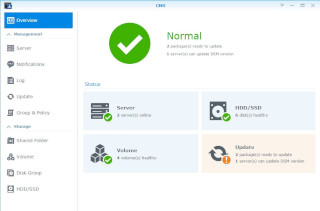
CONCLUSION
The DS715 is a handsome little unit, and the quality of the case is a markedly higher than the DS415+ thanks to the superior hot-swap drive mechanisms and the front bezel.
Pricing is around the $530-550AUD mark, which is about $100 cheaper than the DS415+ - but while the DS715 is a bit less powerful with its ARM-based CPU, itís perfectly capable of performing pretty much anything a small office would require of it. Plus, it has more complete management of expansion units gives much better future proofing, and itís quiet and small.
Pros
As far as NAS units go, it's a good looking device
Might not be the gruntiest, but handles multitasking well.
Good expansion potential without having to commit lots of cash upfront.
Cons
Two disk bays isnít enough for something aimed at SMB. but at least there's options.
Not that much cheaper compared to four drive units, but superior expansion management has to be taken into account.
Feel free to discuss this review in this thread.
|
|
Advertisement:
All original content copyright James Rolfe.
All rights reserved. No reproduction allowed without written permission.
Interested in advertising on OCAU? Contact us for info.
|

|


